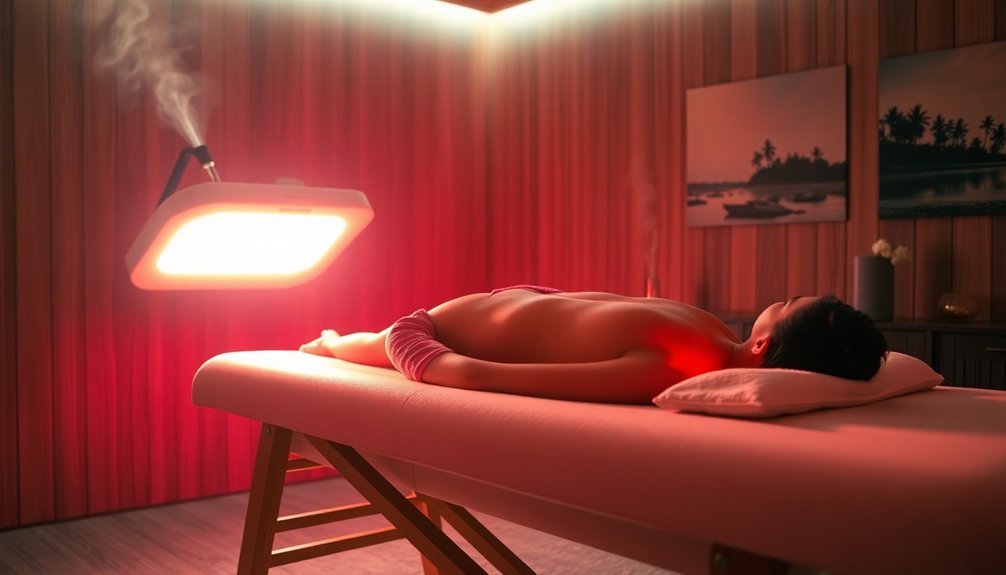Infrared rays boost melatonin production by stimulating your mitochondria, which enhances their function. This stimulation activates cytochrome C oxidase, essential for melatonin synthesis. As darkness falls, your body naturally ramps up melatonin production, but exposure to infrared light can further support this process. Unlike blue light, which interferes with melatonin release, infrared light has minimal disruption, allowing for a smoother shift into sleep. By maintaining a consistent light-dark cycle and incorporating infrared exposure, you can greatly improve your sleep quality and overall well-being. You might find even more surprising benefits as you explore this topic further.
Mechanisms of Infrared Impact

When considering how infrared rays affect melatonin production, it's crucial to understand the underlying mechanisms at play. Infrared light doesn't directly stimulate your pineal gland, which is tucked away under your skull. Instead, melatonin levels are primarily regulated by darkness. When visible light hits your retina, it can suppress melatonin production during the night.
However, infrared light does have an impact on your cells, particularly through stimulating mitochondria, the powerhouse of your cells. This stimulation enhances the production of chemicals like melatonin, which is important for combating oxidative stress. The mitochondria also generate melatonin locally, supporting intercellular balance. Additionally, infrared light can increase melatonin production through enhancing cellular energy, influencing overall metabolic health.
Additionally, infrared light activates specific enzymes and proteins within the mitochondria. An example is cytochrome C oxidase, which plays a significant role in melatonin synthesis. This enzymatic activation is part of a process called photobiomodulation, which enhances cellular function and, subsequently, melatonin production.
The timing of infrared exposure matters. In the evening, when your body naturally begins to produce melatonin, infrared light can further support this process, helping you maintain a healthy sleep-wake cycle.
Sources of Infrared Light
When you think about sources of infrared light, the sun naturally comes to mind as a major contributor.
However, various artificial devices and specialized therapies can also emit infrared light, offering distinct health benefits.
Understanding these sources can help you make informed choices about your exposure to infrared rays and their impact on melatonin production. Direct sunlight is preferred for optimal infrared capture, highlighting its essential role in any discussion about infrared light sources.
Natural Infrared Light Sources
Harnessing the sun's rays, you encounter the most notable natural source of infrared light—sunlight itself. Over 50% of the Sun's energy comes in the form of infrared radiation, making it essential for maintaining healthy melatonin levels in your body. Specifically, the near-infrared radiation slightly exceeds half of the total infrared energy in sunlight, peaking when the sun is at zenith, delivering around 527 watts per square meter. In fact, historical practices of heliotherapy by ancient civilizations highlight the long-recognized benefits of sunlight for health.
Beyond sunlight, natural fires—like campfires, candle flames, and fireplaces—are major emitters of infrared light. They generate far more infrared than visible light, mimicking sunlight's effects on melatonin production. Additionally, these sources provide warmth while helping protect your skin against UV damage.
The Earth itself also plays a critical role, radiating mid-infrared light due to its temperature. This emission is part of the continuous black-body radiation that greatly influences our climate. The plants and vegetation around you reflect near-infrared radiation, further enhancing your exposure to this beneficial spectrum.
Even stars and galaxies contribute to your experience of infrared light, enabling a cosmic connection that deepens your understanding of the universe.
Artificial Infrared Light Devices
Artificial infrared light devices have emerged as effective alternatives to natural sources, providing targeted benefits for health and wellness. You can choose from various types, including handheld devices like the dpl Nuve Pain, which is FDA-approved for treating mild pain and rejuvenating skin.
Full-body light panels and LED pads allow for home usage, delivering professional-grade red and near-infrared light therapy.
These devices operate within specific wavelength ranges; red light typically falls between 630 to 700 nanometers, while near-infrared light ranges from approximately 700 to 900 nanometers. By stimulating your mitochondria, these therapies enhance energy production in your cells.
Mechanisms like photobiomodulation trigger biological changes, assisting in healing processes and improving blood flow through vasodilation.
When using these devices, it's crucial to prioritize high-intensity, professional-grade models to guarantee maximum effectiveness. You won't need protective eyewear for devices like HealthLight therapy pads, giving you added convenience.
Incorporating red light therapy into your routine can yield significant results, especially when paired with good sleep hygiene practices. With the right device, harness the power of infrared light to support your overall health.
Health Benefits of Exposure
Exposure to infrared light offers numerous health benefits that are vital for your overall well-being. These benefits span various aspects of health, from improved cardiovascular function to enhanced brain activity, all while promoting better sleep through melatonin production.
Here are a few key advantages you might experience:
- Boosted Vitamin D levels from natural sunlight, essential for your bone health and immune system.
- Improved cardiovascular health by lowering blood pressure and enhancing blood flow, reducing your risk of heart disease.
- Better brain function and mood, as infrared exposure can alleviate symptoms of depression and improve energy levels.
Harnessing infrared light can be as simple as enjoying outdoor activities, like a walk or a game with friends, ensuring you're soaking up those rays.
You can also benefit indoors by using fire and warm light sources, like candles or incandescent bulbs, to maintain your melatonin levels.
By incorporating these sunlight and warmth sources into your routine, you not only support sleep and recovery but also contribute to your overall health.
Pineal Gland Melatonin Production

When you think about melatonin production in the pineal gland, it's essential to contemplate how light and darkness influence it.
Your body's response to the light-dark cycle plays a central role in regulating melatonin levels, with higher production occurring at night.
The retina's input sends signals to the brain that help synchronize this process with your circadian rhythm.
Light-Dark Cycle Regulation
The intricate relationship between the light-dark cycle and melatonin production in the pineal gland plays a significant role in regulating your sleep-wake patterns.
During daylight, exposure to light inhibits melatonin synthesis, making you feel more awake. As the sun sets, darkness signals your pineal gland to ramp up melatonin production, helping you wind down for the night. This natural rhythm promotes a smooth shift from wakefulness to sleep.
Consider the following aspects of this essential process:
- Nightfall: The dimming of light triggers melatonin release, signaling your body that it's time to rest.
- Daylight: Bright sunlight suppresses melatonin levels, keeping you alert and energized.
- Health Impact: Disruptions in this cycle can lead to sleep disorders, affecting your overall well-being.
The suprachiasmatic nucleus (SCN) in your hypothalamus acts as your body's master clock, coordinating these rhythms and ensuring your melatonin levels align with the natural environment.
Role of Retina Input
Light detection in your retina plays an essential role in regulating melatonin production in the pineal gland. The intrinsically photosensitive retinal ganglion cells in your retina detect light and send inhibitory signals to the paraventricular nucleus of the hypothalamus via the retinohypothalamic tract.
When light is present, these signals inhibit melatonin production; however, in the dark, this inhibition is reduced. Consequently, the paraventricular nucleus becomes disinhibited, activating the superior cervical ganglia.
The superior cervical ganglia innervate the pineal gland, which is vital for melatonin synthesis. As signals travel from the retina to the suprachiasmatic nucleus (SCN) and then the sympathetic nervous system, they coordinate your body's response to light exposure.
Pinealocytes in the gland convert serotonin to melatonin through a light-dependent process, highlighting the important connection between retinal input and melatonin levels.
The type of light matters too—blue light greatly suppresses melatonin production. When retinal input is disrupted, as in blindness, you can experience irregular melatonin cycles and potential circadian rhythm disorders.
Understanding this connection emphasizes the significance of light in regulating your melatonin production.
Circadian Rhythm Effects
Circadian rhythms play an essential role in how your body regulates melatonin production, especially through the actions of the pineal gland. At night, increases in norepinephrine levels stimulate enzymes that convert tryptophan into melatonin, ensuring your sleep cycle aligns with the dark phase. The suprachiasmatic nucleus (SCN) in your brain orchestrates this process, syncing melatonin release with the light-dark cycle.
- Nightfall settles in, painting the sky with rich hues.
- A gentle dip in your core body temperature lulls you toward sleep.
- Melatonin floods your bloodstream, wrapping you in a warm embrace of rest.
The SCN monitors these rhythms, triggering melatonin synthesis when external light dims.
However, even a brief exposure to light at night can disrupt this process, leading to reduced melatonin production. High levels of melatonin correspond to your body's natural sleepiness, helping to maintain a harmonious sleep-wake cycle.
Mitochondrial Melatonin Functions
Mitochondria's many functions are profoundly influenced by melatonin, which serves not only as a powerful antioxidant but also plays a significant role in regulating mitochondrial metabolism and dynamics.
As a high-capacity antioxidant, melatonin directly neutralizes free radicals within mitochondria, promoting the expression of important antioxidant enzymes like superoxide dismutase and catalase. By interacting with reactive oxygen species, it forms metabolites that further reduce free radicals.
Melatonin also fine-tunes mitochondrial metabolism by influencing acetyl-CoA concentrations and enhancing glycolysis through the activation of pyruvate kinase. It stimulates pyruvate dehydrogenase kinase to optimize acetyl-CoA levels, promoting efficient energy production by boosting the electron-transport chain and oxidative phosphorylation.
In terms of mitochondrial health, melatonin inhibits fission while promoting fusion, helping maintain energy supply and avoid oxidative damage.
It also protects against mitochondrial injuries by preserving membrane integrity and regulating calcium levels. By enhancing mitochondrial complex activity and stabilizing membrane potential, melatonin plays an essential role in ensuring the overall health and efficiency of mitochondria, making it a significant player in energy metabolism and protection against oxidative stress.
Effects of Light Types

When it comes to influencing melatonin production, different types of light have distinct effects. Red and infrared light are standout options since they don't greatly disrupt your circadian rhythm. This is why using these lights at night can actually support better sleep.
Exposure to red light specifically can enhance your melatonin levels, helping you wind down for the evening, while near-infrared radiation aids melatonin production at the cellular level, offering additional benefits.
Consider these vivid characteristics of red and infrared light:
- The warm glow of a sunset spilling into your room, soothing your senses.
- The flickering flames of a cozy fire, creating a peaceful atmosphere.
- The soft beam from a dim red nightlight, gently guiding you to sleep.
In contrast, blue light acts as the ultimate melatonin suppressant, disrupting your body's natural rhythms and making it harder to sleep. Green light also reduces melatonin levels, but to a lesser extent.
To maximize melatonin production and improve your sleep quality, you should prioritize red and infrared light while steering clear of blue lights, especially as bedtime approaches.
Health Benefits of Melatonin
Having explored how different light types impact melatonin production, it's important to contemplate the broader health benefits that melatonin brings to your well-being. This powerful hormone primarily regulates your sleep-wake cycle, helping you fall asleep faster and improving the overall quality of your sleep. By reducing the wake-promoting signals of your circadian clock, melatonin makes it easier for you to drift off and wake up refreshed.
Melatonin isn't just good for your sleep; it also supports your eye health. Its antioxidant properties help protect against conditions like glaucoma and age-related macular degeneration, maintaining your visual clarity over time.
In addition, melatonin plays a role in gastrointestinal health by regulating digestion and relieving symptoms of GERD and IBS, making your meals more comfortable.
Beyond these benefits, melatonin aids in managing immune function, blood pressure, and cortisol levels. It can alleviate symptoms of seasonal depression and may reduce the risk of cardiovascular disease.
With its range of health benefits, boosting your melatonin production with infrared rays might just be the key to enhancing both your physical and mental well-being.
Infrared Light Therapy Applications

Utilizing infrared light therapy can offer a range of therapeutic benefits for various health issues. This non-invasive treatment can help you manage pain, promote healing, and address skin conditions effectively.
- Pain Relief: You can experience significant relief from chronic low back pain, postoperative pain after surgeries, and muscle spasms. Infrared therapy increases endorphins, influencing your body's pain gates.
- Healing Acceleration: If you're recovering from an injury or dealing with conditions like pressure sores, infrared light therapy boosts blood flow and collagen production, promoting faster tissue healing and reducing inflammation.
- Musculoskeletal Support: For those managing rheumatoid arthritis or osteoarthritis, this therapy can alleviate pain, reduce joint stiffness, and enhance overall functionality.
With its multifaceted applications, infrared light therapy stands out as a valuable tool in various therapeutic contexts. It not only addresses immediate symptoms but also works on a deeper level, supporting your body's natural healing processes.
This holistic approach makes it a beneficial addition to your wellness regimen, catering to your specific health needs.
Enhancing Sleep Quality
Enhancing sleep quality is essential for overall well-being, and incorporating red and near-infrared light therapy can markedly help. Research shows that exposure to these wavelengths promotes healthy melatonin production, leading to improved sleep quality. When you use red light therapy, you increase melatonin levels in your bloodstream and cells, particularly in the evening when your body naturally prepares for sleep.
Moreover, red light therapy counters the negative effects of blue light, which often disrupts melatonin production. By doing so, it helps you fall asleep faster and stay asleep longer, making it a valuable tool for those struggling with insomnia.
Not only does red light enhance melatonin levels, but it also reduces stress and anxiety, allowing for a more relaxed state conducive to sleep.
Endorphin production increases with this therapy, further improving your mood and promoting relaxation.
Regulation of Circadian Rhythms

Regulating your circadian rhythms is essential for maintaining ideal health and well-being. Light and dark cycles play a vital role in synchronizing your body's master clock, the suprachiasmatic nucleus (SCN). When darkness falls, your pineal gland ramps up melatonin production, signaling it's time to sleep. Conversely, exposure to light, particularly in the morning, helps you feel awake and alert.
- The sun rising in the morning, marking a vibrant start to the day
- A peaceful room dimmed for sleep, inviting rest and tranquility
- The rhythmic chirping of crickets at night, echoing nature's bedtime
Your melatonin levels naturally increase about two hours before you sleep, promoting a smoother shift into rest.
Environmental factors like food intake, stress, and physical activity also influence these rhythms. Regular routines establish consistency, helping your SCN effectively manage the cycle of wakefulness and sleep.
Frequently Asked Questions
How Does Infrared Light Differ From Other Light Types in Effects?
Infrared light differs from other types by having a longer wavelength, which doesn't suppress melatonin production like blue light. It penetrates deeper, stimulating mitochondria and promoting healing while supporting your body's natural sleep cycle.
Can Infrared Light Therapy Be Harmful in Any Way?
Yes, infrared light therapy can be harmful. You might experience burns, eye damage, or skin irritation. It's essential to follow guidelines, use protection, and consult a healthcare provider if you have conditions or take medications.
How Long Should I Expose Myself to Infrared Light?
You should expose yourself to infrared light for at least 10-20 minutes daily. If using red light therapy, sessions can last between 10-30 minutes, based on your device and desired benefits.
Is the Infrared Light From Devices as Effective as Sunlight?
Yes, infrared light from devices can be effective, but make certain they operate within the right wavelength and intensity. Compared to sunlight, they're beneficial, especially in low-light situations, but natural sources remain superior for overall melatonin production.
Are There Specific Times Best for Infrared Light Exposure?
The best times for infrared light exposure are during sunrise and sunset. These times allow ideal penetration of beneficial red and infrared light, enhancing your skin's protection and supporting your overall health effectively.
In Summary
In conclusion, infrared rays play an essential role in boosting melatonin production by influencing the pineal gland and enhancing mitochondrial functions. By understanding how infrared light interacts with our biology, you can leverage its benefits to improve your sleep quality and regulate your circadian rhythms. Whether through natural sunlight or infrared light therapy, harnessing this powerful light source can lead to better health and well-being, helping you feel more rested and rejuvenated each day.





Leave a Reply